An In-depth Analysis of Inflation and Its Impact on Canada
VerifiedAdded on 2022/12/15
|10
|2356
|498
Report
AI Summary
This economics report examines the impact of inflation on the Canadian economy. The analysis begins with an introduction to inflation and its measurement, then explores the relationship between inflation and key economic indicators such as GDP, unemployment, fiscal policy, and monetary policy. The report highlights the fluctuating nature of inflation in Canada and its potential causes, including changes in aggregate demand and supply. It discusses the role of the Bank of Canada in managing inflation through monetary policy, including setting the bank rate and controlling the money supply. The report also analyzes the effects of fiscal policy on inflation and concludes with an overview of the challenges Canada faces in managing inflation and maintaining economic stability, including the impact of factors like aggregate demand and supply. The report uses economic principles to analyze the effects of inflation and provides recommendations to address the economic problem.
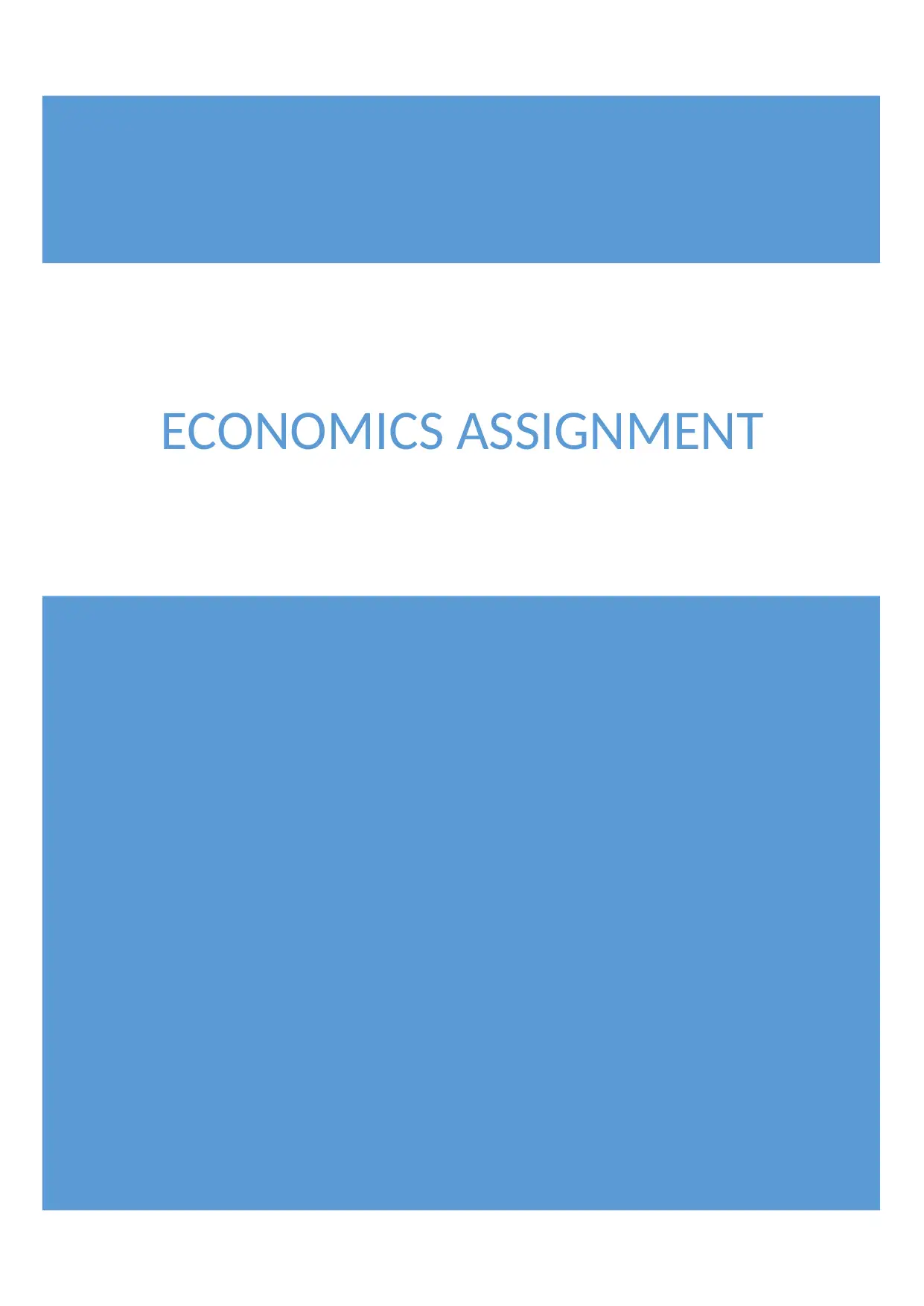
ECONOMICS ASSIGNMENT
Paraphrase This Document
Need a fresh take? Get an instant paraphrase of this document with our AI Paraphraser
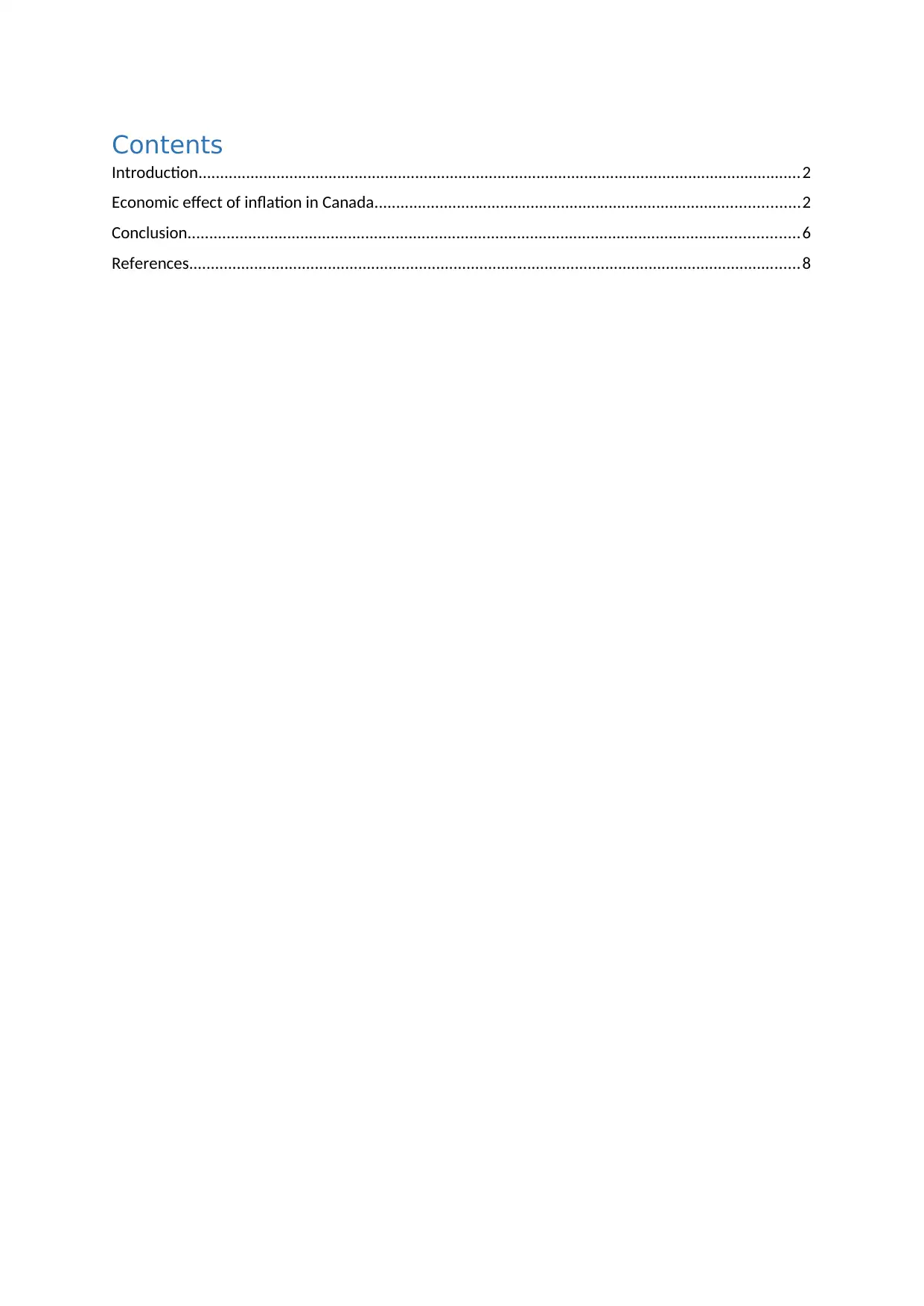
Contents
Introduction...........................................................................................................................................2
Economic effect of inflation in Canada..................................................................................................2
Conclusion.............................................................................................................................................6
References.............................................................................................................................................8
Introduction...........................................................................................................................................2
Economic effect of inflation in Canada..................................................................................................2
Conclusion.............................................................................................................................................6
References.............................................................................................................................................8
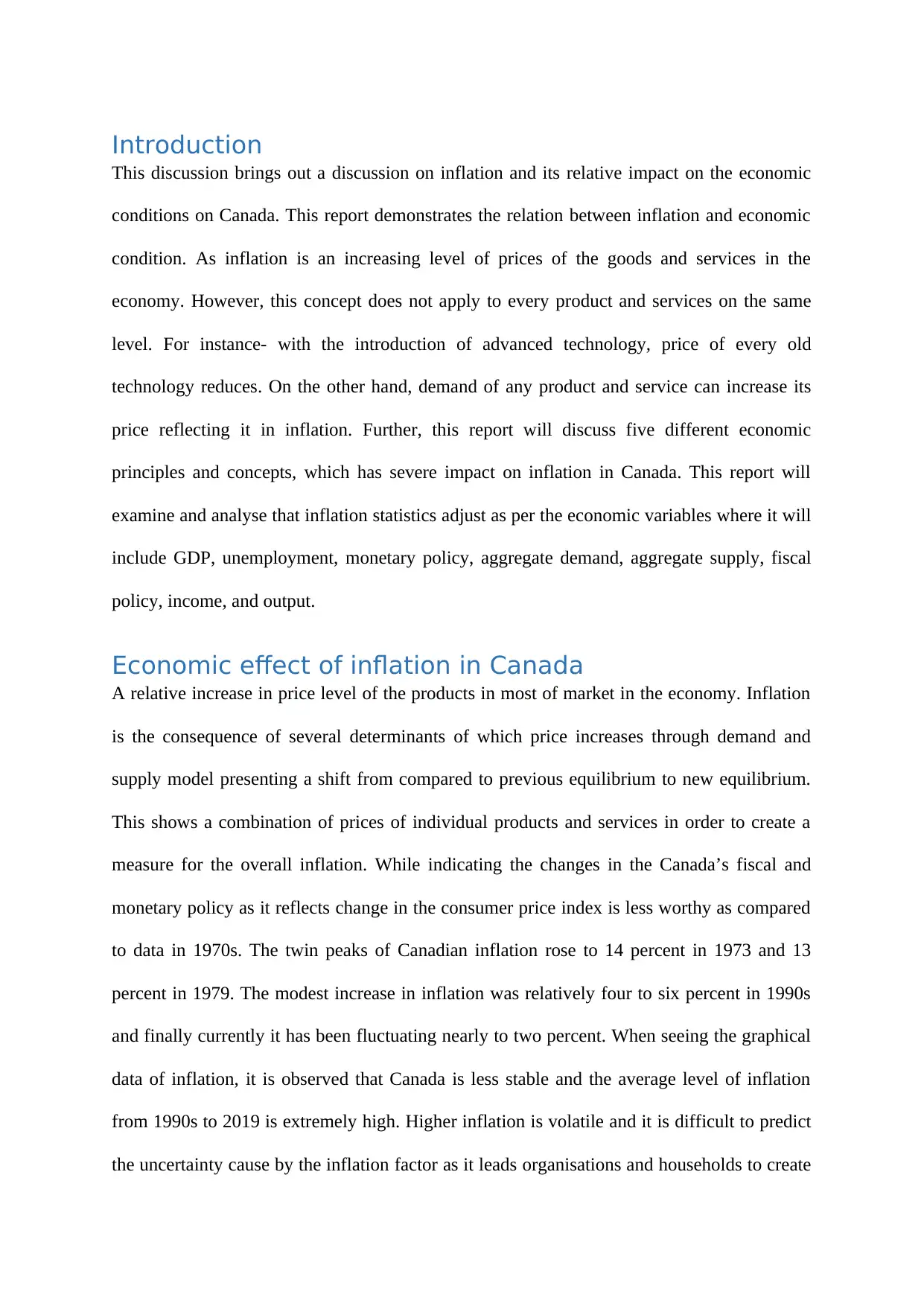
Introduction
This discussion brings out a discussion on inflation and its relative impact on the economic
conditions on Canada. This report demonstrates the relation between inflation and economic
condition. As inflation is an increasing level of prices of the goods and services in the
economy. However, this concept does not apply to every product and services on the same
level. For instance- with the introduction of advanced technology, price of every old
technology reduces. On the other hand, demand of any product and service can increase its
price reflecting it in inflation. Further, this report will discuss five different economic
principles and concepts, which has severe impact on inflation in Canada. This report will
examine and analyse that inflation statistics adjust as per the economic variables where it will
include GDP, unemployment, monetary policy, aggregate demand, aggregate supply, fiscal
policy, income, and output.
Economic effect of inflation in Canada
A relative increase in price level of the products in most of market in the economy. Inflation
is the consequence of several determinants of which price increases through demand and
supply model presenting a shift from compared to previous equilibrium to new equilibrium.
This shows a combination of prices of individual products and services in order to create a
measure for the overall inflation. While indicating the changes in the Canada’s fiscal and
monetary policy as it reflects change in the consumer price index is less worthy as compared
to data in 1970s. The twin peaks of Canadian inflation rose to 14 percent in 1973 and 13
percent in 1979. The modest increase in inflation was relatively four to six percent in 1990s
and finally currently it has been fluctuating nearly to two percent. When seeing the graphical
data of inflation, it is observed that Canada is less stable and the average level of inflation
from 1990s to 2019 is extremely high. Higher inflation is volatile and it is difficult to predict
the uncertainty cause by the inflation factor as it leads organisations and households to create
This discussion brings out a discussion on inflation and its relative impact on the economic
conditions on Canada. This report demonstrates the relation between inflation and economic
condition. As inflation is an increasing level of prices of the goods and services in the
economy. However, this concept does not apply to every product and services on the same
level. For instance- with the introduction of advanced technology, price of every old
technology reduces. On the other hand, demand of any product and service can increase its
price reflecting it in inflation. Further, this report will discuss five different economic
principles and concepts, which has severe impact on inflation in Canada. This report will
examine and analyse that inflation statistics adjust as per the economic variables where it will
include GDP, unemployment, monetary policy, aggregate demand, aggregate supply, fiscal
policy, income, and output.
Economic effect of inflation in Canada
A relative increase in price level of the products in most of market in the economy. Inflation
is the consequence of several determinants of which price increases through demand and
supply model presenting a shift from compared to previous equilibrium to new equilibrium.
This shows a combination of prices of individual products and services in order to create a
measure for the overall inflation. While indicating the changes in the Canada’s fiscal and
monetary policy as it reflects change in the consumer price index is less worthy as compared
to data in 1970s. The twin peaks of Canadian inflation rose to 14 percent in 1973 and 13
percent in 1979. The modest increase in inflation was relatively four to six percent in 1990s
and finally currently it has been fluctuating nearly to two percent. When seeing the graphical
data of inflation, it is observed that Canada is less stable and the average level of inflation
from 1990s to 2019 is extremely high. Higher inflation is volatile and it is difficult to predict
the uncertainty cause by the inflation factor as it leads organisations and households to create
⊘ This is a preview!⊘
Do you want full access?
Subscribe today to unlock all pages.

Trusted by 1+ million students worldwide
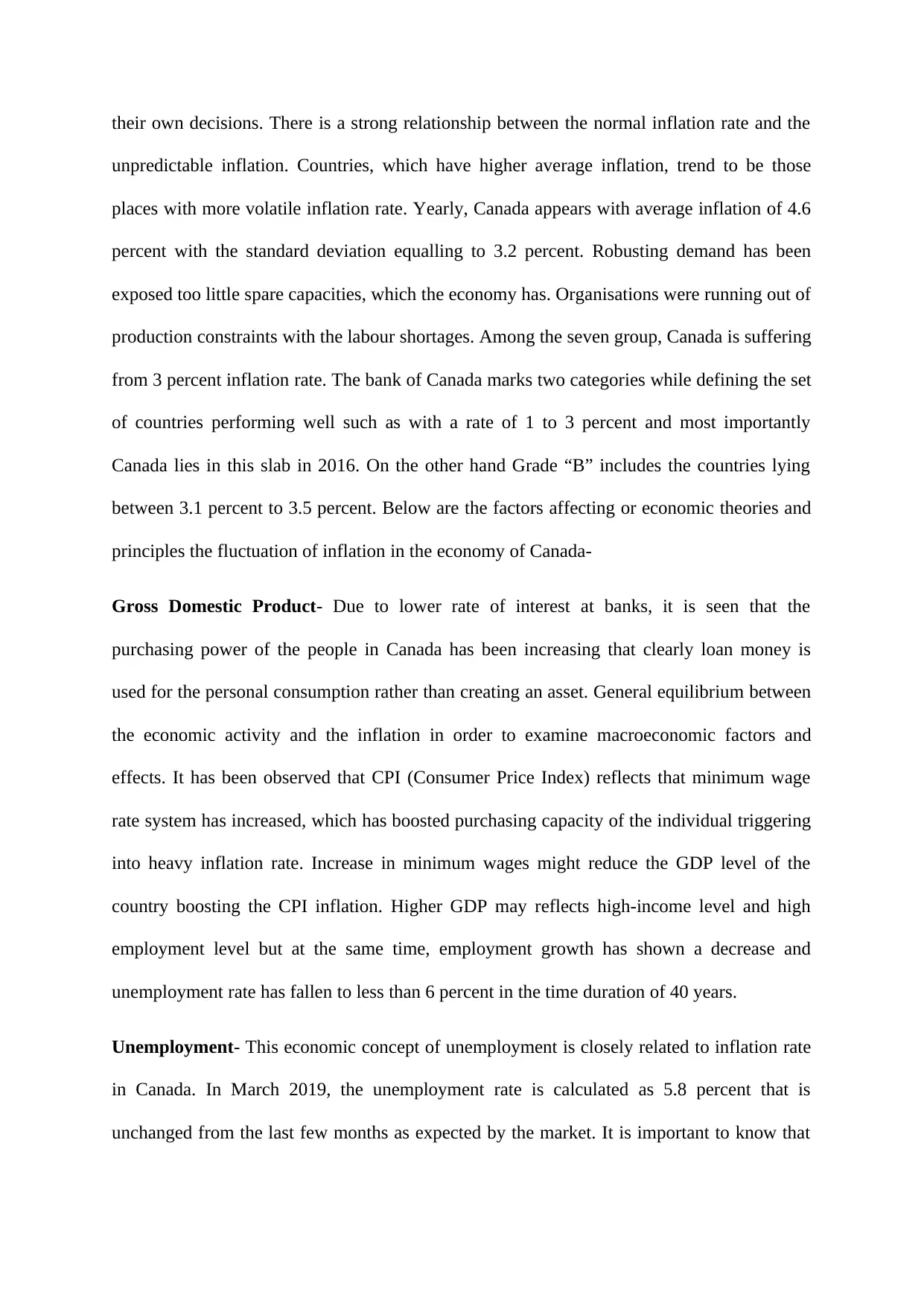
their own decisions. There is a strong relationship between the normal inflation rate and the
unpredictable inflation. Countries, which have higher average inflation, trend to be those
places with more volatile inflation rate. Yearly, Canada appears with average inflation of 4.6
percent with the standard deviation equalling to 3.2 percent. Robusting demand has been
exposed too little spare capacities, which the economy has. Organisations were running out of
production constraints with the labour shortages. Among the seven group, Canada is suffering
from 3 percent inflation rate. The bank of Canada marks two categories while defining the set
of countries performing well such as with a rate of 1 to 3 percent and most importantly
Canada lies in this slab in 2016. On the other hand Grade “B” includes the countries lying
between 3.1 percent to 3.5 percent. Below are the factors affecting or economic theories and
principles the fluctuation of inflation in the economy of Canada-
Gross Domestic Product- Due to lower rate of interest at banks, it is seen that the
purchasing power of the people in Canada has been increasing that clearly loan money is
used for the personal consumption rather than creating an asset. General equilibrium between
the economic activity and the inflation in order to examine macroeconomic factors and
effects. It has been observed that CPI (Consumer Price Index) reflects that minimum wage
rate system has increased, which has boosted purchasing capacity of the individual triggering
into heavy inflation rate. Increase in minimum wages might reduce the GDP level of the
country boosting the CPI inflation. Higher GDP may reflects high-income level and high
employment level but at the same time, employment growth has shown a decrease and
unemployment rate has fallen to less than 6 percent in the time duration of 40 years.
Unemployment- This economic concept of unemployment is closely related to inflation rate
in Canada. In March 2019, the unemployment rate is calculated as 5.8 percent that is
unchanged from the last few months as expected by the market. It is important to know that
unpredictable inflation. Countries, which have higher average inflation, trend to be those
places with more volatile inflation rate. Yearly, Canada appears with average inflation of 4.6
percent with the standard deviation equalling to 3.2 percent. Robusting demand has been
exposed too little spare capacities, which the economy has. Organisations were running out of
production constraints with the labour shortages. Among the seven group, Canada is suffering
from 3 percent inflation rate. The bank of Canada marks two categories while defining the set
of countries performing well such as with a rate of 1 to 3 percent and most importantly
Canada lies in this slab in 2016. On the other hand Grade “B” includes the countries lying
between 3.1 percent to 3.5 percent. Below are the factors affecting or economic theories and
principles the fluctuation of inflation in the economy of Canada-
Gross Domestic Product- Due to lower rate of interest at banks, it is seen that the
purchasing power of the people in Canada has been increasing that clearly loan money is
used for the personal consumption rather than creating an asset. General equilibrium between
the economic activity and the inflation in order to examine macroeconomic factors and
effects. It has been observed that CPI (Consumer Price Index) reflects that minimum wage
rate system has increased, which has boosted purchasing capacity of the individual triggering
into heavy inflation rate. Increase in minimum wages might reduce the GDP level of the
country boosting the CPI inflation. Higher GDP may reflects high-income level and high
employment level but at the same time, employment growth has shown a decrease and
unemployment rate has fallen to less than 6 percent in the time duration of 40 years.
Unemployment- This economic concept of unemployment is closely related to inflation rate
in Canada. In March 2019, the unemployment rate is calculated as 5.8 percent that is
unchanged from the last few months as expected by the market. It is important to know that
Paraphrase This Document
Need a fresh take? Get an instant paraphrase of this document with our AI Paraphraser
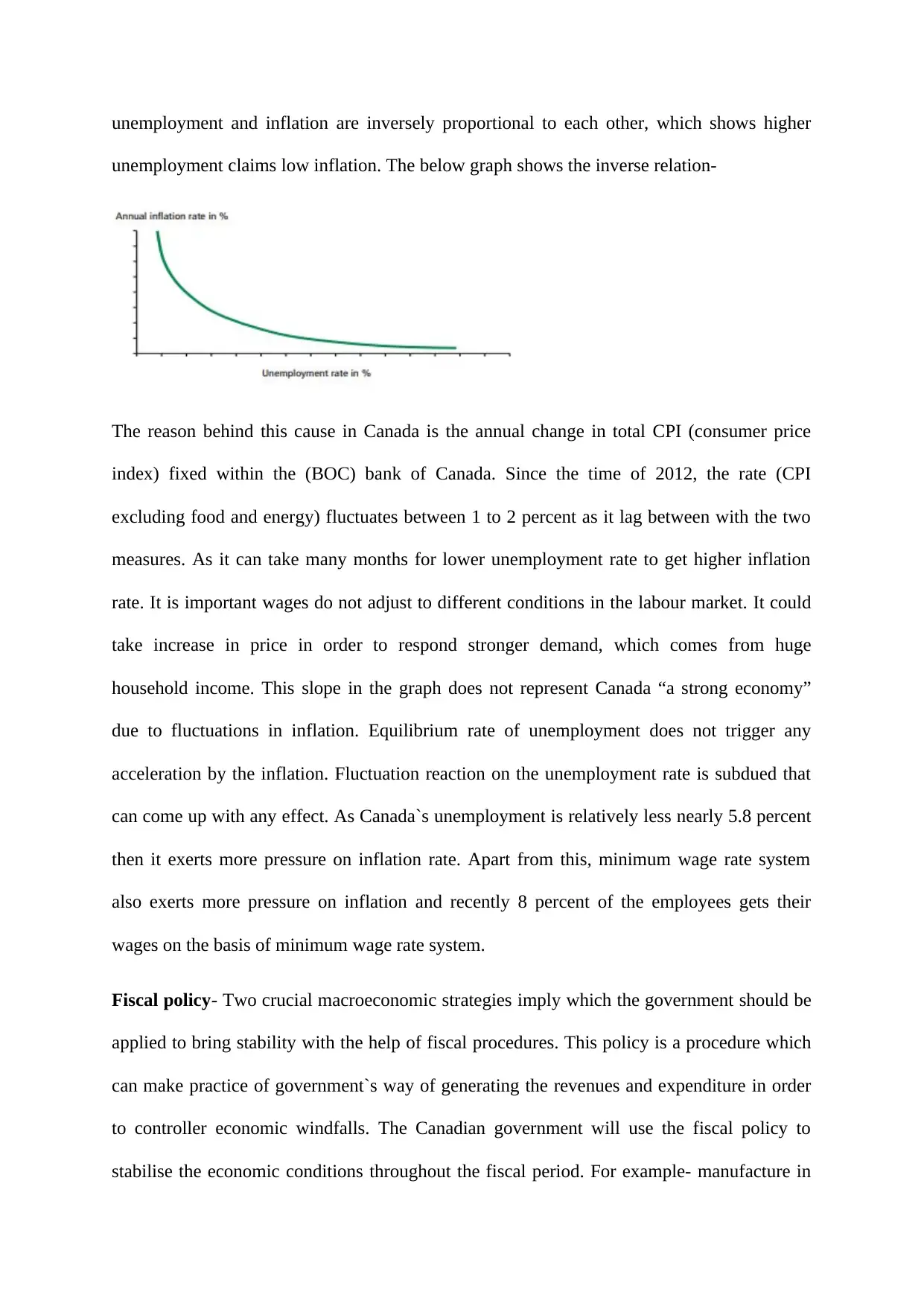
unemployment and inflation are inversely proportional to each other, which shows higher
unemployment claims low inflation. The below graph shows the inverse relation-
The reason behind this cause in Canada is the annual change in total CPI (consumer price
index) fixed within the (BOC) bank of Canada. Since the time of 2012, the rate (CPI
excluding food and energy) fluctuates between 1 to 2 percent as it lag between with the two
measures. As it can take many months for lower unemployment rate to get higher inflation
rate. It is important wages do not adjust to different conditions in the labour market. It could
take increase in price in order to respond stronger demand, which comes from huge
household income. This slope in the graph does not represent Canada “a strong economy”
due to fluctuations in inflation. Equilibrium rate of unemployment does not trigger any
acceleration by the inflation. Fluctuation reaction on the unemployment rate is subdued that
can come up with any effect. As Canada`s unemployment is relatively less nearly 5.8 percent
then it exerts more pressure on inflation rate. Apart from this, minimum wage rate system
also exerts more pressure on inflation and recently 8 percent of the employees gets their
wages on the basis of minimum wage rate system.
Fiscal policy- Two crucial macroeconomic strategies imply which the government should be
applied to bring stability with the help of fiscal procedures. This policy is a procedure which
can make practice of government`s way of generating the revenues and expenditure in order
to controller economic windfalls. The Canadian government will use the fiscal policy to
stabilise the economic conditions throughout the fiscal period. For example- manufacture in
unemployment claims low inflation. The below graph shows the inverse relation-
The reason behind this cause in Canada is the annual change in total CPI (consumer price
index) fixed within the (BOC) bank of Canada. Since the time of 2012, the rate (CPI
excluding food and energy) fluctuates between 1 to 2 percent as it lag between with the two
measures. As it can take many months for lower unemployment rate to get higher inflation
rate. It is important wages do not adjust to different conditions in the labour market. It could
take increase in price in order to respond stronger demand, which comes from huge
household income. This slope in the graph does not represent Canada “a strong economy”
due to fluctuations in inflation. Equilibrium rate of unemployment does not trigger any
acceleration by the inflation. Fluctuation reaction on the unemployment rate is subdued that
can come up with any effect. As Canada`s unemployment is relatively less nearly 5.8 percent
then it exerts more pressure on inflation rate. Apart from this, minimum wage rate system
also exerts more pressure on inflation and recently 8 percent of the employees gets their
wages on the basis of minimum wage rate system.
Fiscal policy- Two crucial macroeconomic strategies imply which the government should be
applied to bring stability with the help of fiscal procedures. This policy is a procedure which
can make practice of government`s way of generating the revenues and expenditure in order
to controller economic windfalls. The Canadian government will use the fiscal policy to
stabilise the economic conditions throughout the fiscal period. For example- manufacture in
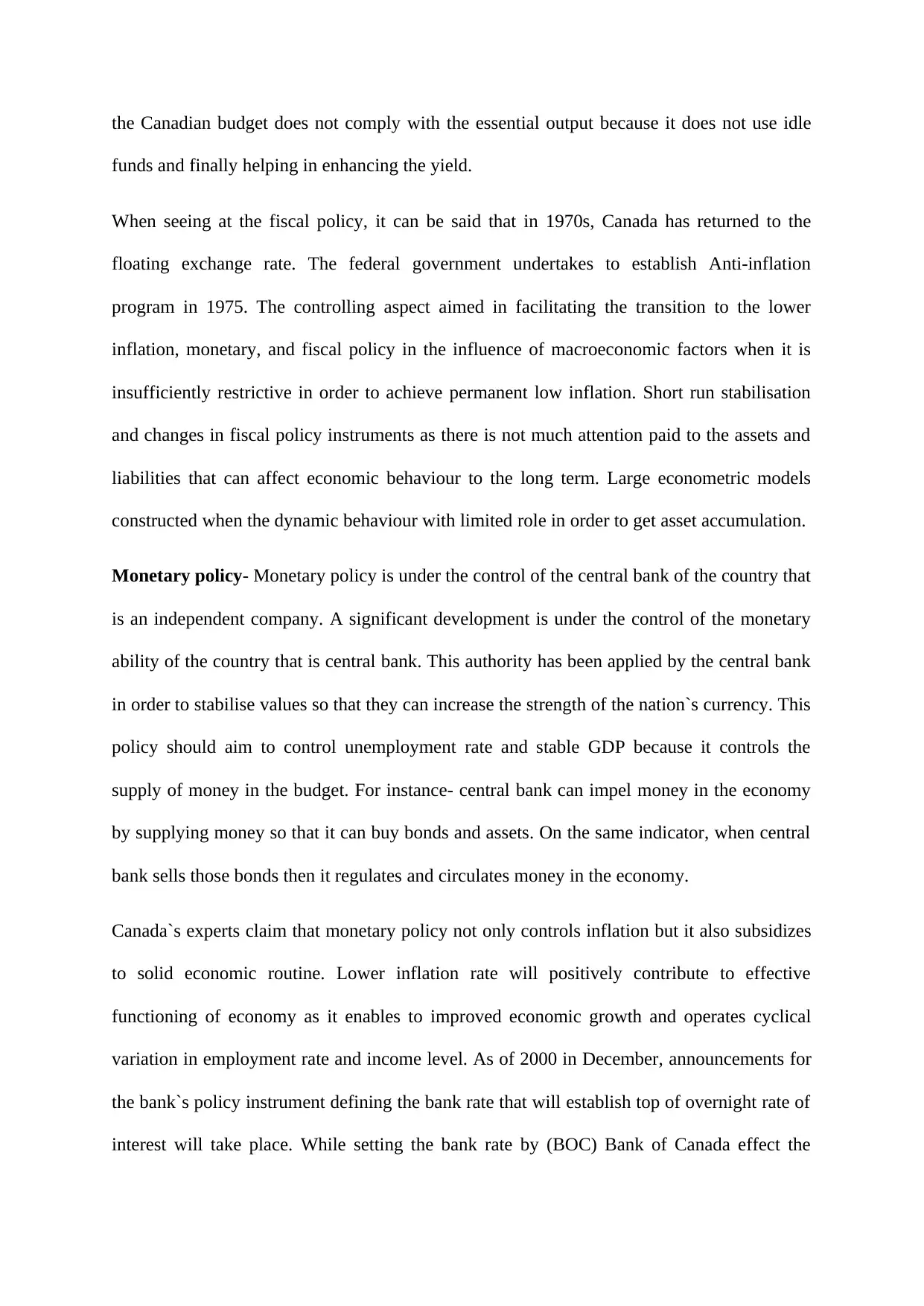
the Canadian budget does not comply with the essential output because it does not use idle
funds and finally helping in enhancing the yield.
When seeing at the fiscal policy, it can be said that in 1970s, Canada has returned to the
floating exchange rate. The federal government undertakes to establish Anti-inflation
program in 1975. The controlling aspect aimed in facilitating the transition to the lower
inflation, monetary, and fiscal policy in the influence of macroeconomic factors when it is
insufficiently restrictive in order to achieve permanent low inflation. Short run stabilisation
and changes in fiscal policy instruments as there is not much attention paid to the assets and
liabilities that can affect economic behaviour to the long term. Large econometric models
constructed when the dynamic behaviour with limited role in order to get asset accumulation.
Monetary policy- Monetary policy is under the control of the central bank of the country that
is an independent company. A significant development is under the control of the monetary
ability of the country that is central bank. This authority has been applied by the central bank
in order to stabilise values so that they can increase the strength of the nation`s currency. This
policy should aim to control unemployment rate and stable GDP because it controls the
supply of money in the budget. For instance- central bank can impel money in the economy
by supplying money so that it can buy bonds and assets. On the same indicator, when central
bank sells those bonds then it regulates and circulates money in the economy.
Canada`s experts claim that monetary policy not only controls inflation but it also subsidizes
to solid economic routine. Lower inflation rate will positively contribute to effective
functioning of economy as it enables to improved economic growth and operates cyclical
variation in employment rate and income level. As of 2000 in December, announcements for
the bank`s policy instrument defining the bank rate that will establish top of overnight rate of
interest will take place. While setting the bank rate by (BOC) Bank of Canada effect the
funds and finally helping in enhancing the yield.
When seeing at the fiscal policy, it can be said that in 1970s, Canada has returned to the
floating exchange rate. The federal government undertakes to establish Anti-inflation
program in 1975. The controlling aspect aimed in facilitating the transition to the lower
inflation, monetary, and fiscal policy in the influence of macroeconomic factors when it is
insufficiently restrictive in order to achieve permanent low inflation. Short run stabilisation
and changes in fiscal policy instruments as there is not much attention paid to the assets and
liabilities that can affect economic behaviour to the long term. Large econometric models
constructed when the dynamic behaviour with limited role in order to get asset accumulation.
Monetary policy- Monetary policy is under the control of the central bank of the country that
is an independent company. A significant development is under the control of the monetary
ability of the country that is central bank. This authority has been applied by the central bank
in order to stabilise values so that they can increase the strength of the nation`s currency. This
policy should aim to control unemployment rate and stable GDP because it controls the
supply of money in the budget. For instance- central bank can impel money in the economy
by supplying money so that it can buy bonds and assets. On the same indicator, when central
bank sells those bonds then it regulates and circulates money in the economy.
Canada`s experts claim that monetary policy not only controls inflation but it also subsidizes
to solid economic routine. Lower inflation rate will positively contribute to effective
functioning of economy as it enables to improved economic growth and operates cyclical
variation in employment rate and income level. As of 2000 in December, announcements for
the bank`s policy instrument defining the bank rate that will establish top of overnight rate of
interest will take place. While setting the bank rate by (BOC) Bank of Canada effect the
⊘ This is a preview!⊘
Do you want full access?
Subscribe today to unlock all pages.

Trusted by 1+ million students worldwide
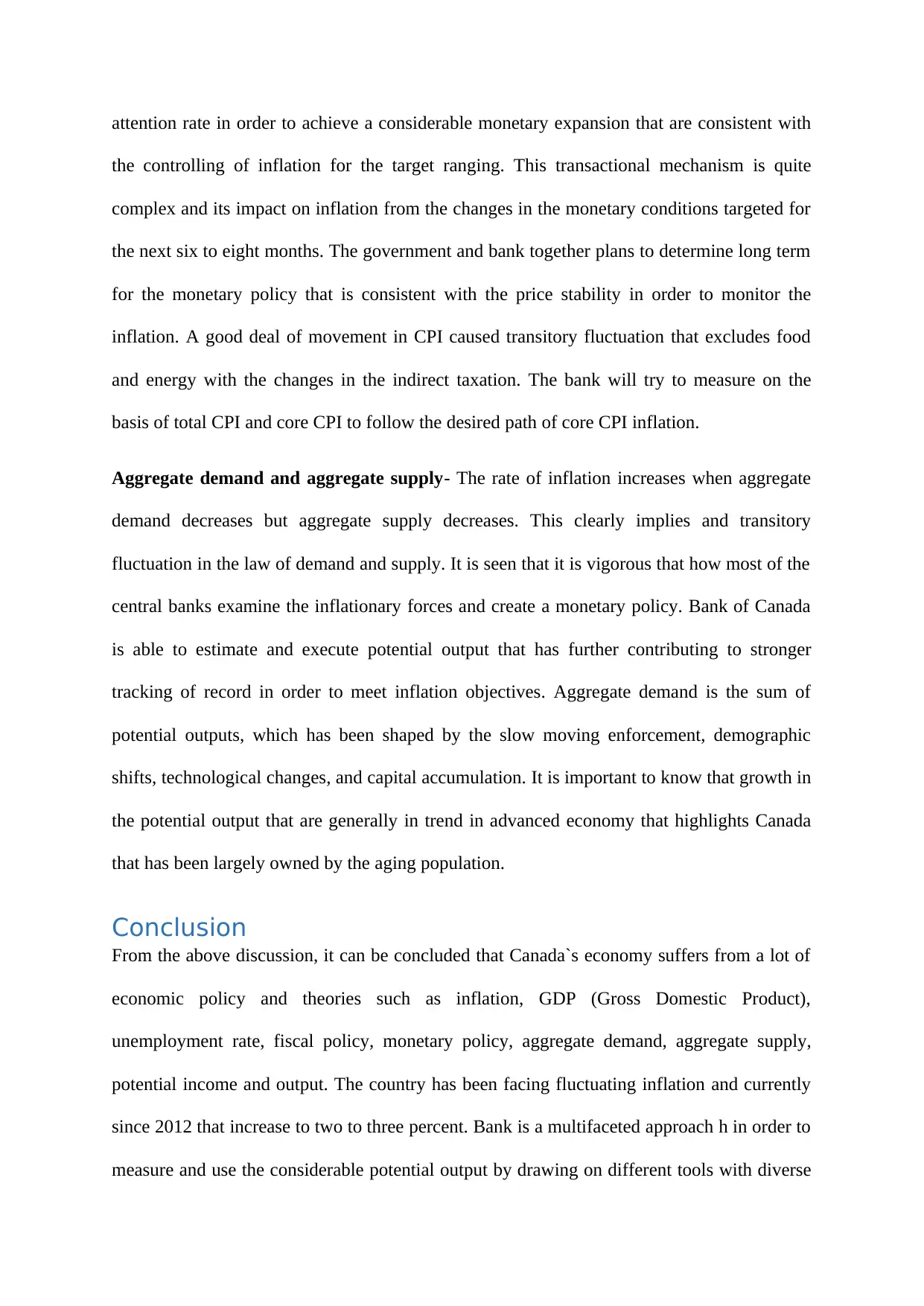
attention rate in order to achieve a considerable monetary expansion that are consistent with
the controlling of inflation for the target ranging. This transactional mechanism is quite
complex and its impact on inflation from the changes in the monetary conditions targeted for
the next six to eight months. The government and bank together plans to determine long term
for the monetary policy that is consistent with the price stability in order to monitor the
inflation. A good deal of movement in CPI caused transitory fluctuation that excludes food
and energy with the changes in the indirect taxation. The bank will try to measure on the
basis of total CPI and core CPI to follow the desired path of core CPI inflation.
Aggregate demand and aggregate supply- The rate of inflation increases when aggregate
demand decreases but aggregate supply decreases. This clearly implies and transitory
fluctuation in the law of demand and supply. It is seen that it is vigorous that how most of the
central banks examine the inflationary forces and create a monetary policy. Bank of Canada
is able to estimate and execute potential output that has further contributing to stronger
tracking of record in order to meet inflation objectives. Aggregate demand is the sum of
potential outputs, which has been shaped by the slow moving enforcement, demographic
shifts, technological changes, and capital accumulation. It is important to know that growth in
the potential output that are generally in trend in advanced economy that highlights Canada
that has been largely owned by the aging population.
Conclusion
From the above discussion, it can be concluded that Canada`s economy suffers from a lot of
economic policy and theories such as inflation, GDP (Gross Domestic Product),
unemployment rate, fiscal policy, monetary policy, aggregate demand, aggregate supply,
potential income and output. The country has been facing fluctuating inflation and currently
since 2012 that increase to two to three percent. Bank is a multifaceted approach h in order to
measure and use the considerable potential output by drawing on different tools with diverse
the controlling of inflation for the target ranging. This transactional mechanism is quite
complex and its impact on inflation from the changes in the monetary conditions targeted for
the next six to eight months. The government and bank together plans to determine long term
for the monetary policy that is consistent with the price stability in order to monitor the
inflation. A good deal of movement in CPI caused transitory fluctuation that excludes food
and energy with the changes in the indirect taxation. The bank will try to measure on the
basis of total CPI and core CPI to follow the desired path of core CPI inflation.
Aggregate demand and aggregate supply- The rate of inflation increases when aggregate
demand decreases but aggregate supply decreases. This clearly implies and transitory
fluctuation in the law of demand and supply. It is seen that it is vigorous that how most of the
central banks examine the inflationary forces and create a monetary policy. Bank of Canada
is able to estimate and execute potential output that has further contributing to stronger
tracking of record in order to meet inflation objectives. Aggregate demand is the sum of
potential outputs, which has been shaped by the slow moving enforcement, demographic
shifts, technological changes, and capital accumulation. It is important to know that growth in
the potential output that are generally in trend in advanced economy that highlights Canada
that has been largely owned by the aging population.
Conclusion
From the above discussion, it can be concluded that Canada`s economy suffers from a lot of
economic policy and theories such as inflation, GDP (Gross Domestic Product),
unemployment rate, fiscal policy, monetary policy, aggregate demand, aggregate supply,
potential income and output. The country has been facing fluctuating inflation and currently
since 2012 that increase to two to three percent. Bank is a multifaceted approach h in order to
measure and use the considerable potential output by drawing on different tools with diverse
Paraphrase This Document
Need a fresh take? Get an instant paraphrase of this document with our AI Paraphraser
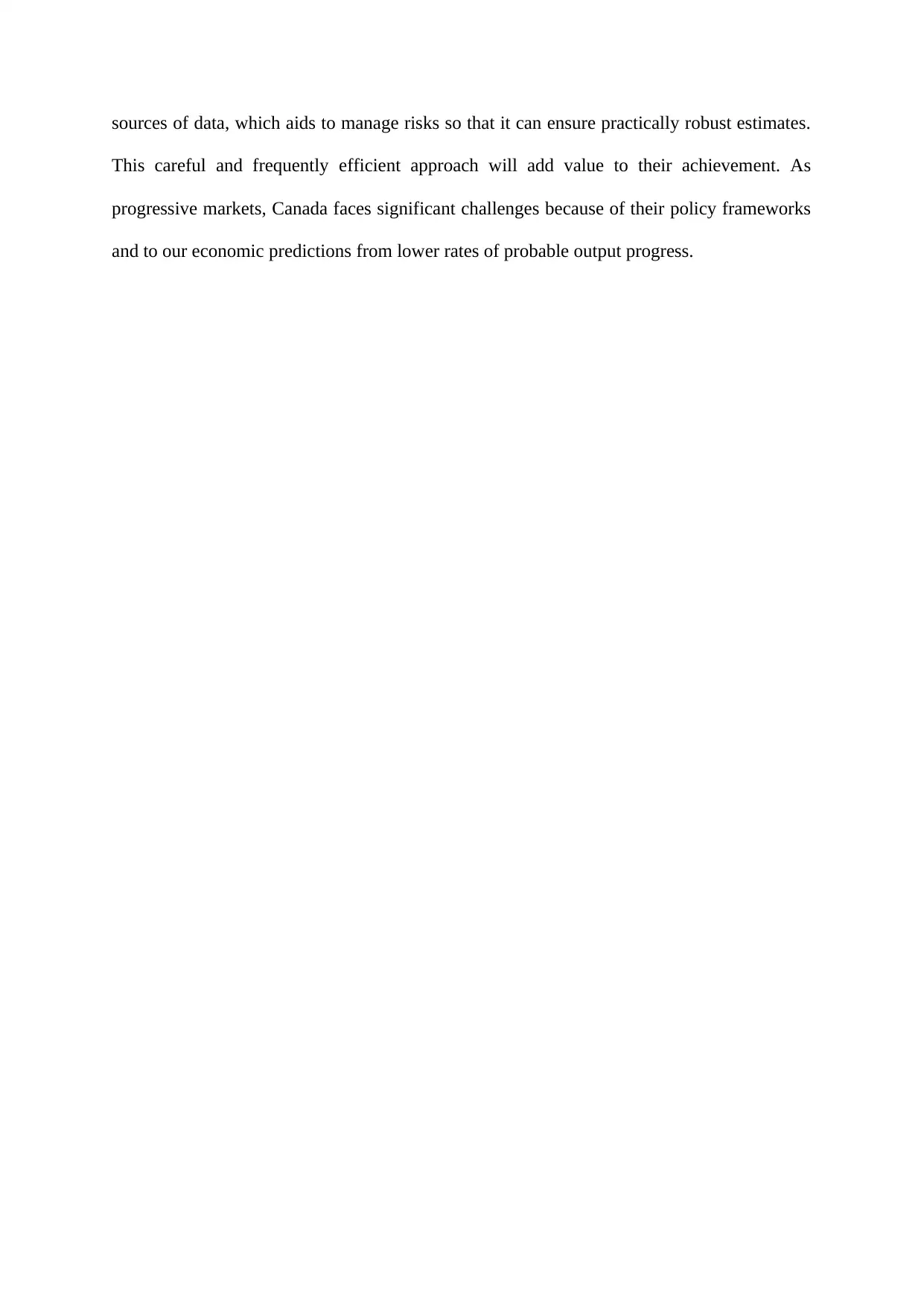
sources of data, which aids to manage risks so that it can ensure practically robust estimates.
This careful and frequently efficient approach will add value to their achievement. As
progressive markets, Canada faces significant challenges because of their policy frameworks
and to our economic predictions from lower rates of probable output progress.
This careful and frequently efficient approach will add value to their achievement. As
progressive markets, Canada faces significant challenges because of their policy frameworks
and to our economic predictions from lower rates of probable output progress.
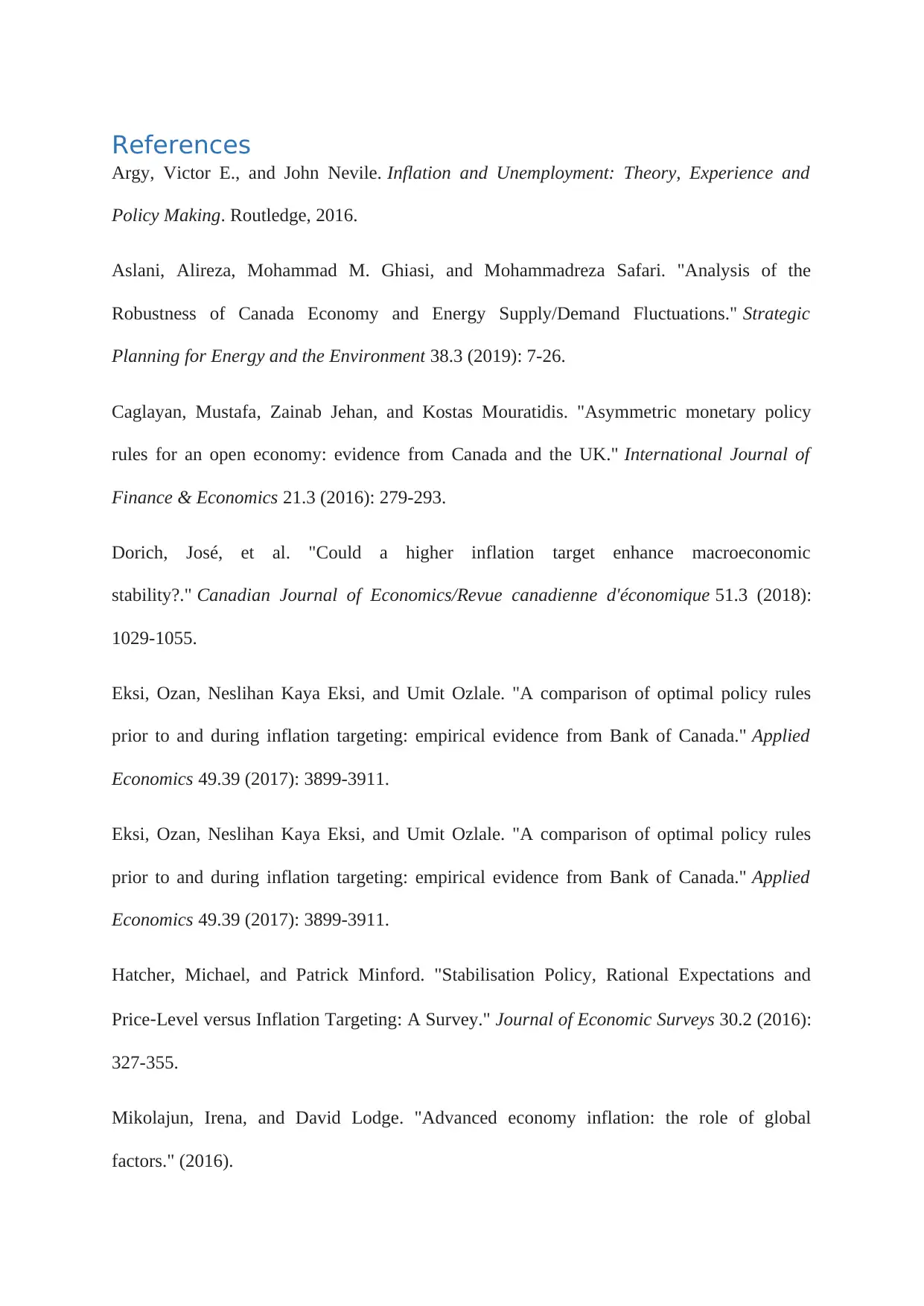
References
Argy, Victor E., and John Nevile. Inflation and Unemployment: Theory, Experience and
Policy Making. Routledge, 2016.
Aslani, Alireza, Mohammad M. Ghiasi, and Mohammadreza Safari. "Analysis of the
Robustness of Canada Economy and Energy Supply/Demand Fluctuations." Strategic
Planning for Energy and the Environment 38.3 (2019): 7-26.
Caglayan, Mustafa, Zainab Jehan, and Kostas Mouratidis. "Asymmetric monetary policy
rules for an open economy: evidence from Canada and the UK." International Journal of
Finance & Economics 21.3 (2016): 279-293.
Dorich, José, et al. "Could a higher inflation target enhance macroeconomic
stability?." Canadian Journal of Economics/Revue canadienne d'économique 51.3 (2018):
1029-1055.
Eksi, Ozan, Neslihan Kaya Eksi, and Umit Ozlale. "A comparison of optimal policy rules
prior to and during inflation targeting: empirical evidence from Bank of Canada." Applied
Economics 49.39 (2017): 3899-3911.
Eksi, Ozan, Neslihan Kaya Eksi, and Umit Ozlale. "A comparison of optimal policy rules
prior to and during inflation targeting: empirical evidence from Bank of Canada." Applied
Economics 49.39 (2017): 3899-3911.
Hatcher, Michael, and Patrick Minford. "Stabilisation Policy, Rational Expectations and
Price‐Level versus Inflation Targeting: A Survey." Journal of Economic Surveys 30.2 (2016):
327-355.
Mikolajun, Irena, and David Lodge. "Advanced economy inflation: the role of global
factors." (2016).
Argy, Victor E., and John Nevile. Inflation and Unemployment: Theory, Experience and
Policy Making. Routledge, 2016.
Aslani, Alireza, Mohammad M. Ghiasi, and Mohammadreza Safari. "Analysis of the
Robustness of Canada Economy and Energy Supply/Demand Fluctuations." Strategic
Planning for Energy and the Environment 38.3 (2019): 7-26.
Caglayan, Mustafa, Zainab Jehan, and Kostas Mouratidis. "Asymmetric monetary policy
rules for an open economy: evidence from Canada and the UK." International Journal of
Finance & Economics 21.3 (2016): 279-293.
Dorich, José, et al. "Could a higher inflation target enhance macroeconomic
stability?." Canadian Journal of Economics/Revue canadienne d'économique 51.3 (2018):
1029-1055.
Eksi, Ozan, Neslihan Kaya Eksi, and Umit Ozlale. "A comparison of optimal policy rules
prior to and during inflation targeting: empirical evidence from Bank of Canada." Applied
Economics 49.39 (2017): 3899-3911.
Eksi, Ozan, Neslihan Kaya Eksi, and Umit Ozlale. "A comparison of optimal policy rules
prior to and during inflation targeting: empirical evidence from Bank of Canada." Applied
Economics 49.39 (2017): 3899-3911.
Hatcher, Michael, and Patrick Minford. "Stabilisation Policy, Rational Expectations and
Price‐Level versus Inflation Targeting: A Survey." Journal of Economic Surveys 30.2 (2016):
327-355.
Mikolajun, Irena, and David Lodge. "Advanced economy inflation: the role of global
factors." (2016).
⊘ This is a preview!⊘
Do you want full access?
Subscribe today to unlock all pages.

Trusted by 1+ million students worldwide
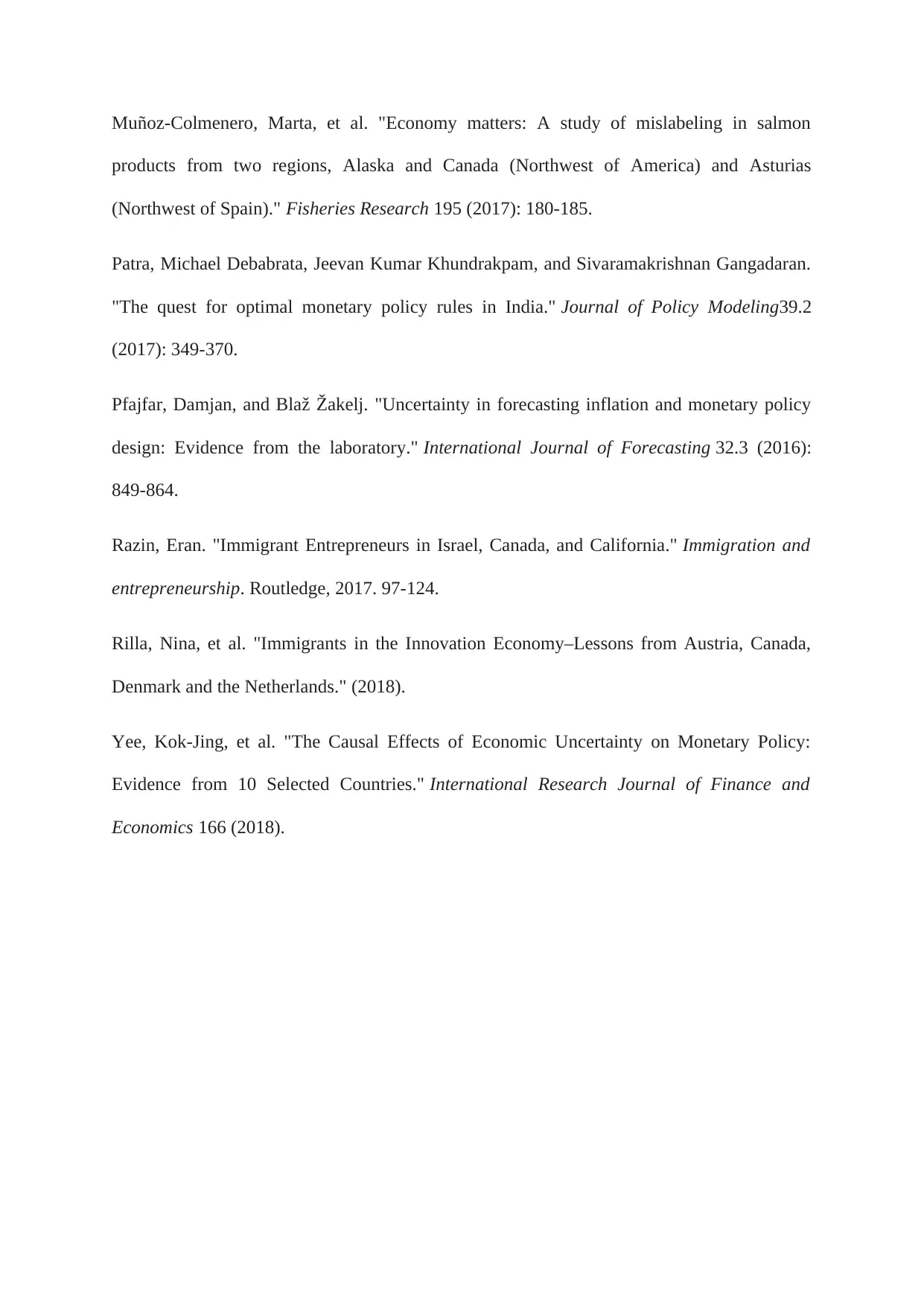
Muñoz-Colmenero, Marta, et al. "Economy matters: A study of mislabeling in salmon
products from two regions, Alaska and Canada (Northwest of America) and Asturias
(Northwest of Spain)." Fisheries Research 195 (2017): 180-185.
Patra, Michael Debabrata, Jeevan Kumar Khundrakpam, and Sivaramakrishnan Gangadaran.
"The quest for optimal monetary policy rules in India." Journal of Policy Modeling39.2
(2017): 349-370.
Pfajfar, Damjan, and Blaž Žakelj. "Uncertainty in forecasting inflation and monetary policy
design: Evidence from the laboratory." International Journal of Forecasting 32.3 (2016):
849-864.
Razin, Eran. "Immigrant Entrepreneurs in Israel, Canada, and California." Immigration and
entrepreneurship. Routledge, 2017. 97-124.
Rilla, Nina, et al. "Immigrants in the Innovation Economy–Lessons from Austria, Canada,
Denmark and the Netherlands." (2018).
Yee, Kok-Jing, et al. "The Causal Effects of Economic Uncertainty on Monetary Policy:
Evidence from 10 Selected Countries." International Research Journal of Finance and
Economics 166 (2018).
products from two regions, Alaska and Canada (Northwest of America) and Asturias
(Northwest of Spain)." Fisheries Research 195 (2017): 180-185.
Patra, Michael Debabrata, Jeevan Kumar Khundrakpam, and Sivaramakrishnan Gangadaran.
"The quest for optimal monetary policy rules in India." Journal of Policy Modeling39.2
(2017): 349-370.
Pfajfar, Damjan, and Blaž Žakelj. "Uncertainty in forecasting inflation and monetary policy
design: Evidence from the laboratory." International Journal of Forecasting 32.3 (2016):
849-864.
Razin, Eran. "Immigrant Entrepreneurs in Israel, Canada, and California." Immigration and
entrepreneurship. Routledge, 2017. 97-124.
Rilla, Nina, et al. "Immigrants in the Innovation Economy–Lessons from Austria, Canada,
Denmark and the Netherlands." (2018).
Yee, Kok-Jing, et al. "The Causal Effects of Economic Uncertainty on Monetary Policy:
Evidence from 10 Selected Countries." International Research Journal of Finance and
Economics 166 (2018).
1 out of 10
Related Documents
Your All-in-One AI-Powered Toolkit for Academic Success.
+13062052269
info@desklib.com
Available 24*7 on WhatsApp / Email
![[object Object]](/_next/static/media/star-bottom.7253800d.svg)
Unlock your academic potential
Copyright © 2020–2025 A2Z Services. All Rights Reserved. Developed and managed by ZUCOL.





